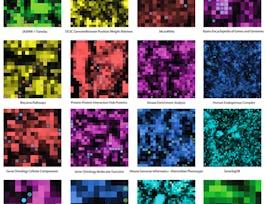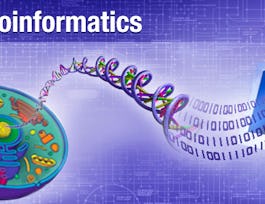The past 15 years have been exciting ones in plant biology. Hundreds of plant genomes have been sequenced, RNA-seq has enabled transcriptome-wide expression profiling, and a proliferation of "-seq"-based methods has permitted protein-protein and protein-DNA interactions to be determined cheaply and in a high-throughput manner. These data sets in turn allow us to generate hypotheses at the click of a mouse or tap of a finger.



Plant Bioinformatics Capstone
This course is part of Plant Bioinformatic Methods Specialization

Instructor: Nicholas James Provart
Sponsored by Coursera for Reliance Family
4,416 already enrolled
(28 reviews)
Skills you'll gain
Details to know

Add to your LinkedIn profile
3 assignments
See how employees at top companies are mastering in-demand skills

Build your subject-matter expertise
- Learn new concepts from industry experts
- Gain a foundational understanding of a subject or tool
- Develop job-relevant skills with hands-on projects
- Earn a shareable career certificate


Earn a career certificate
Add this credential to your LinkedIn profile, resume, or CV
Share it on social media and in your performance review

There are 5 modules in this course
In the Week 1 module, we are going to use an example gene of (mostly) unknown function from Arabidopsis, At3g20300, and see what online databases can tell us about that gene. Part A uses tools that we have explored in Plant Bioinformatics to gather information about the gene/gene product, such as its size, what its homologs are, phylogenetic relationship to other sequences, domain information, and subcellular localization. Part B explores gene expression databases to see where that gene is expressed. Often where and when a gene is expressed can give us clues as to its function.
What's included
2 readings1 assignment
Often the function of genes that are coexpressed with a gene of unknown function can give us hints about the function of that gene. Researchers are now often using coexpression analyses as “primary screens” to identify “new” genes in biological pathways (a few examples are described in Usadel et al., 2009). Another interesting facet is whether the promoters of these sets of coexpressed genes contain any common cis-regulatory motifs. In Part A, we’ll explore the genes that are coexpressed with At3g20300, and in Part B, we’ll look for common regulatory motifs.
What's included
2 readings1 assignment
Gene Ontology enrichment analysis for a set of coexpressed gene is often useful for figuring out what that group of genes is doing. By doing such analyses with a set of coexpressed genes can we infer a role for our gene of unknown function? We'll explore this aspect in Part A, along with investigating potential pathways the gene list is involved in. In Part B, we'll use other network tools to investigate additional linkages to other genes, above and beyond those suggested by coexpression. It is sometimes useful to investigate these too! Again, we'll be using At3g20300 as our example.
What's included
2 readings1 assignment
Now we will take the above analyses and synthesize the information from them into a draft lab report/essay describing the putative function of our gene of interest with unknown function. We'll draw on the literature to describe what is known about related genes, and propose some experiments to test our hypotheses about our gene's potential function.
What's included
2 readings1 peer review
Based on feedback from peer reviews, we'll polish our draft to submit a final report! The report should be around 13-15 pages long (double spaced) including figures, which should be included inline. The page count does not include Methods or References (see Example Essay for format).
What's included
1 peer review
Instructor

Offered by
Why people choose Coursera for their career




Learner reviews
28 reviews
- 5 stars
82.14%
- 4 stars
10.71%
- 3 stars
7.14%
- 2 stars
0%
- 1 star
0%
Showing 3 of 28
Reviewed on Jun 22, 2020
Excellent bioinformatic training and experience. It gave me confidence in how to do the online work. Thank you.
Reviewed on Jun 5, 2023
The course was quite enlightening and educative. It has provided me with more information about other plant databases apart from NCBI that I know of.
Recommended if you're interested in Physical Science and Engineering

Icahn School of Medicine at Mount Sinai

Peking University

Fred Hutchinson Cancer Center

Open new doors with Coursera Plus
Unlimited access to 10,000+ world-class courses, hands-on projects, and job-ready certificate programs - all included in your subscription
Advance your career with an online degree
Earn a degree from world-class universities - 100% online
Join over 3,400 global companies that choose Coursera for Business
Upskill your employees to excel in the digital economy



